Chip in Now to Stand Up for Working People
Working people need a voice more than ever and Working America is making that happen.
Working people need a voice more than ever and Working America is making that happen.


09/25/2017
OVERVIEW
Working America canvassers held face-to-face conversations with 355 likely midterm swing voters in central Ohio in early June. During these front-porch discussions, we surveyed midterm voters on their top issues and 11 public policies designed to address economic and public health concerns. The list included eight middle-class-oriented policies, two policies targeting low-income workers, and the American Health Care Act, or Trumpcare. We wanted to understand if and where working people are feeling pinched and what solutions they believe will deliver meaningful change to their lives. We also asked about their source for political news and views of politicians. Here are our findings:
There is strong support in Ohio for an array of progressive policies to expand and strengthen the middle class. During our 355 face-to-face conversations, we found solid support across partisan lines and income levels to curb the outsourcing of jobs, address the opioid crisis and pass paid family leave. These three policies have such high levels of support and intensity that they could prove persuasive even for Trump swing voters in 2018. In addition, five other progressive policies promoting middle-class well-being are backed by more than 70 percent of Clinton voters and at least a plurality of Trump voters we spoke with during this project.
Trumpcare is intensely opposed by Clinton swing voters and weakly supported by Trump swing voters. Only 39 percent of Trump voters — and a mere 2 percent of Clinton voters — support the passage of Trumpcare. Overall, 60 percent of Ohio swing voters we spoke with chose it from a list of 11 policies as the one that would have the most negative impact on their family. Voters in both camps identify health care as their most important issue, so a candidate’s stance on Trumpcare could be hugely persuasive in 2018.
While there is a path forward for Ohio progressives in 2018, voters’ low information about elected officials is helping to drive a low opinion of all politicians. Our conversations with Ohio swing voters reveal they know little about their elected officials; half of them say they do not know or have no opinion of either U.S. senator. And a substantial share of voters told us they get their news from right-leaning media sources; 49 percent of Trump voters rely on Fox or other TV news as their primary news source. Overall, voters are far more likely to hold “all politicians” responsible for the state of the economy rather than one political party, Wall Street or corporations. In 2016, Democrats in Ohio tried and failed to use conventional paid media to push back against right-wing messages. In 2018, progressives need to change the way we get information to voters and do far more direct outreach. Having better policies won’t make a difference if voters never hear about them.
KEY FINDINGS
The findings in this report are based on “front porch focus groups” — interviews held in person at voters’ front doors. Working America canvassers conducted the interviews from June 5 to June 16 in working- and middle-class neighborhoods in Columbus and several surrounding towns as well as in Circleville, Delaware and Mansfield. The people we spoke with voted in at least one nonpresidential election since 2010, which suggests they are likely to vote in 2018. These voters landed squarely in the middle of the partisan spectrum with an average Catalist Vote Choice partisanship score of 48.2 (on a scale of 0-100, 0 being most Republican and 100 being most Democrat). The estimated household income of voters averaged roughly $88,000 a year. Ninety-eight percent of voters were white, 1 percent were African-American, none were Latinx and 0.3 percent were Asian; the ethnicity of 0.3 percent was unknown.
| MIDDLE-CLASS POLICIES |
|---|
| 1. Expand overtime pay 2. Make it easier to form a union 3. Ensure seven paid sick days 4. Ensure 12 weeks paid FMLA 5. Discourage outsourcing of jobs 6. End misclassification 7. Address the opioid crisis 8. Make it easier to save for retirement |
DISCUSSION OF FINDINGS
1. What Voters Think About Policies to Strengthen the Middle Class
Working America canvassers talked with Ohio swing voters about eight policies designed to strengthen and expand the middle class. Their responses show there is broad support, even among Trump swing voters, for many progressive policies.
In South Columbus, one of our canvassers talked with Robert, a 51-year-old white Trump voter who wanted Democrats “to stop with the [Russia] investigation crap.” But Robert supported all eight progressive policies, including making it easier to unionize. He related how he’d tried to form a union at work and feared he’d lose his job. On many issues, Trump swing voters shared powerful stories from their own lives that explained why they backed progressive policies. This doesn’t mean Trump swing voters will automatically pull the lever for a progressive in 2018. But it’s a good reminder that some of these voters swung from Barack Obama to Trump and that policies relevant to their lives may help swing them back in a progressive direction.
For all the policies that follow, we measured both the level of support and the level of intensity that voters had for each policy. We measured the level of support by asking voters whether they supported, opposed or felt neutral about each policy. We measured intensity by asking voters which policies they thought would have the greatest positive or negative impact on their families. For the full set of results, please see the charts in the Appendix.
1.A. Broad, Intense Support for Three Policies to Bolster the Middle Class
Chart 1 shows three middle-class-oriented policies that garnered the support of at least two-thirds of Trump voters and an overwhelming majority of Clinton voters. Trump voters also ranked these policies as the top 3 out of 8 middle-class-oriented policies that would have the greatest positive impact on their lives. All three policies had strong support across income and party lines, and they appear to have sufficient intensity to be persuasive with voters in 2018.
Looking at support, three policies rose to the top across partisanship: curbing outsourcing, addressing the opioid crisis and passing paid family leave. Looking at intensity of support, we see that among the broadly supported policies, these three also ranked as the most likely to have a positive impact on the lives of Ohioans. They resonate across the board. Beneath the charts is a more detailed analysis of each policy.
CHART 1. MIDTERM VOTERS’ MOST POPULAR POLICIES
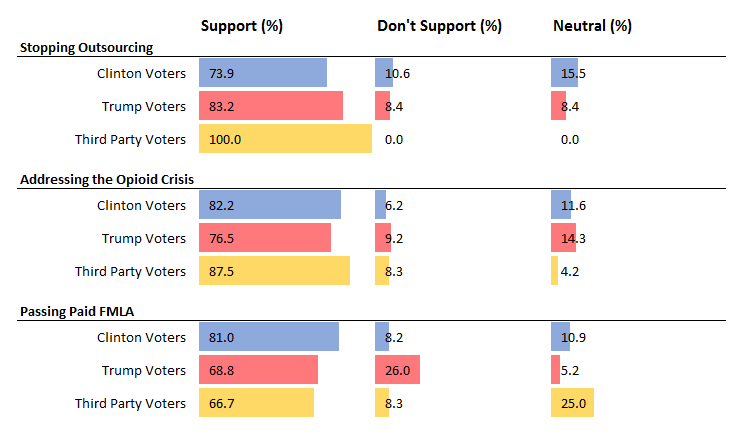
Stopping Outsourcing – Overall, 79.3 percent of Ohio swing voters told us they want lawmakers to discourage companies from outsourcing jobs and encourage them to provide good wages and benefits through tax incentives. Voters ranked it first among the eight middle-class-oriented policies as the one that would have the greatest positive impact. Stopping outsourcing received more support from Trump swing voters than any other policy, with 83.2 percent of them backing the measure. And it wasn’t just displaced factory workers who complained about outsourcing. White-collar workers had concerns as well.
Jeanne, 64, a white Clinton voter from Delaware, has retired from JPMorgan Chase but is still upset about the bank outsourcing jobs while it pays the CEO tens of millions of dollars. “If he could live in a $2 million instead of a $5 million mansion,” she said, “then maybe 300 people can keep their $60,000-a-year job that supports a family and their community. These people at the top don’t care about communities like they should.”
Addressing the Opioid Crisis – Voters overwhelmingly said elected officials should address the opioid crisis. Trump voters ranked it second and Clinton voters ranked it first among the eight middle-class policies as the one having the greatest positive impact. Overall, it received the highest level of support of the eight middle-class policies tested, with 80.3 percent of all Ohio swing voters backing it.
Passing Paid Family and Medical Leave (FMLA) – Some of the most powerful stories we heard came from voters who spoke about the difference that 12 weeks of paid family and medical leave would make in their lives.
David, 62, a Trump voter and mechanic from South Columbus, strongly supported FMLA. “I wish I was able to spend time at home when my wife was ill a few years back,” he said. “Family leave would have helped us remain strong as a family during rough times.”
Katherine, 33, a registered Republican from Hilliard, is a public school teacher, mother of a 2-year old and is about to have another baby. She wishes she could get more time off after the delivery. “[Even though] I’m in the teachers’ union, I only get six weeks’ paid leave when I have the baby,” Katherine said.
There was a dramatic gender gap over the FMLA policy, with 85 percent of all women voters supporting it versus just 66.9 percent of men. Overall, 76 percent of voters support FMLA (including 69% of Trump voters and 81% of Clinton voters); it ranked third out of the eight middle-class policies as the one having the greatest positive impact.
In addition to our question about paid FMLA, we also asked voters about a separate policy to ensure 7 paid sick days for all workers. Interestingly, the paid-sick-days policy received less support and registered lower intensity among voters than paid FMLA. A possible explanation for that difference can be found in the anecdotes our canvassers heard. A number of people, especially higher-income voters, said they already had paid sick days at work, and indicated that paid family leave would make a bigger impact on their lives. This anecdotal evidence is consistent with our intensity numbers. Where paid FMLA ranked third among the eight middle-class-oriented policies as the one that would have the greatest positive impact, paid sick days ranked sixth and so fell into the second tier of policies we tested.
1.B. Five Progressive Policies with Broad but Less Intense Support
While the three middle-class-oriented policies above generated broad and intense support among voters in both parties and at all income levels, the five middle-class-oriented policies below also received support from two-thirds or more of Clinton voters and at least a plurality of Trump voters. Though these policies are less likely to motivate voters in 2018, some of them could be persuasive for swing voters.
CHART 2. MIDDLE-CLASS POLICIES SUPPORTED BY MIDTERM VOTERS
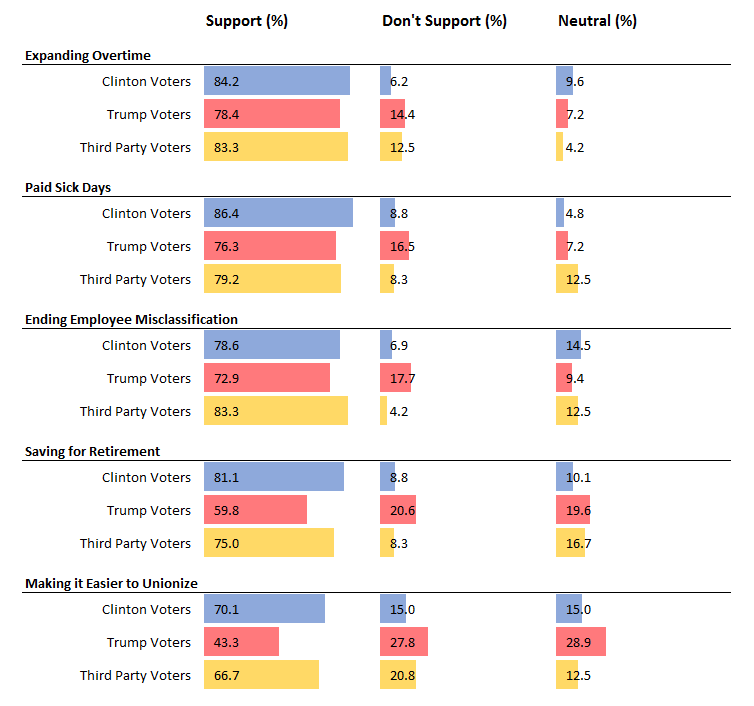
Expanding Overtime – Expanding overtime pay to those making less than $47,000 a year was the second most popular middle-class policy among all swing voters. Overall, 80.2 percent of voters supported expanding overtime. The policy drew strong support from voters at all income levels, making it look at first glance like a very appealing measure for progressives looking to broaden their appeal. One potential drawback, however, is that relatively few voters felt it would benefit them directly. It ranked fifth out of the eight middle-class policies as the one having the greatest positive impact.
Paid Sick Days – Overall, 74.1 percent of voters support establishing seven paid sick days a year for every worker. Among all voters, it ranked sixth out of the eight middle-class policies as the one having the greatest positive impact. There was also a gender gap over this policy, with 88.2 percent of women supporting paid sick days compared to just 76.1 percent of men.
Ending Employee Misclassification – Once again, personal experience was an important driver for a number of the voters we talked with about ending employee misclassification. That’s the all-too-common practice of employers wrongly classifying workers as independent contractors and denying them the benefits and rights of regular employees.
Christopher, 33, a white Trump voter from Columbus, said he was very glad to see someone addressing employee misclassification. He had been a contractor at Wright-Patterson Air Force Base, but grew frustrated by the lack of benefits and concern over his contract being renewed. He said it was a problem many of his friends struggled with too.
Ending employee misclassification was backed by 77.6 percent of all voters we surveyed, but it ranked seventh out of the eight middle-class policies as the one having the greatest positive impact. It should also be noted that Working America canvassers spent more time explaining this policy to voters than any other, so, despite the fact that nearly half a million Ohio workers may be misclassified, it would likely require voter education to make it a persuasive issue.
Saving for Retirement – There was a notable drop-off in support for this measure among Trump voters; just 59.8 percent backed a policy making it easier for people who don’t have a regular full-time job to save for retirement. However, 81 percent of Clinton voters supported it, and among all voters it ranked fourth out of the eight middle-class policies as the one having the greatest positive impact.
Making It Easier to Unionize – Given the right-wing assault on organized labor, it may seem surprising that a plurality of Trump swing voters want to make it less risky to form a union. But organized labor has deep roots in Ohio, and our canvassers talked with a number of Trump voters who live or grew up in union households and appreciate the boost it gave them. Clinton voters also had strong personal stories to tell about unions.
Tim, 58, a white Clinton voter from Gahanna, talked about the way that people’s standard of living has “been peeled back since the late ’70s and ’80s.” But when he was growing up, Tim said, his father “worked at GM and made enough to support a family of six. That was a union job.”
Overall, 59.4 percent of voters support a policy making it easier to form a union. However, one sign that the right-wing assault on unions has had an impact in Ohio is that among all voters, it ranked eighth out of the eight middle-class policies as the one having the greatest positive impact on their lives.
****
2. Strong Feelings About Health Care & Weak Support for Trumpcare
The GOP push to pass Trumpcare has focused the minds of Ohio voters on health care. Up until the 2016 election and for years before, jobs and the economy had been the most important issue to voters surveyed by Working America. But during our canvass, with Obamacare and Trumpcare in the news almost daily, health care ranked as the top issue for both Clinton and Trump voters. As long as the relentless — and largely negative — focus on Trumpcare continues, that represents a serious problem for Republicans and an opportunity for Democrats.
Republicans hoping to drum up support for Trumpcare may want to bypass Ohio. Even Trump voters are skittish when asked if they want to repeal Obamacare and replace it with Trumpcare. Just 38.8 percent of Trump swing voters say they back Trumpcare. A larger share, 43.9 percent, say they’re neutral, and 17.3 percent oppose it outright.
CHART 3. MIDTERM VOTERS’ SUPPORT FOR TRUMPCARE

During our canvass, we tested a total of 11 public policies: the eight middle-class-oriented policies above; two policies targeting low-income workers (which are discussed below); and Trumpcare. It was far and away the most reviled policy, with 59.7 percent of all voters saying it would have the most negative impact on their lives. Even Trump voters ranked it as the second most negative policy on their list of 11, and many of them worried about its possible effects.
Tyler, 31, a white Trump voter from Circleville, was deeply concerned about Trumpcare. His son “just got heart surgery and if [Trumpcare won’t] cover pre-existing conditions, then I don’t want it,” he said.
Kerin, 55, a white Trump supporter from Gahanna, said she hates Obamacare because her family couldn’t afford a plan and had to pay the penalty for not having coverage. Even so, she said she’s still not sure she supports Trumpcare.
Clinton swing voters in Ohio are overwhelmingly opposed to Trumpcare: 87.2 percent oppose it and just 2 percent of Clinton voters support passage. Given the highly negative perception of Trumpcare, it is certain to be a highly persuasive issue for Clinton voters. Even many Trump swing voters could be persuaded by arguments against it.
****
3. The Potential Power of the Minimum Wage
The response to the eight middle-class-oriented policies above shows there is still some common ground for Trump and Clinton swing voters. However, when we talked with voters about two policies designed to improve the fortunes of lower-income workers, we saw the kind of polarization that characterizes so much of American politics today.
These two policies — raising the minimum wage, and fining corporations that pay low wages — both provoked a strong negative reaction from Trump swing voters. And only the minimum wage showed some promise for energizing Clinton voters.
CHART 4. POLARIZING ISSUES FOR MID-TERM VOTERS
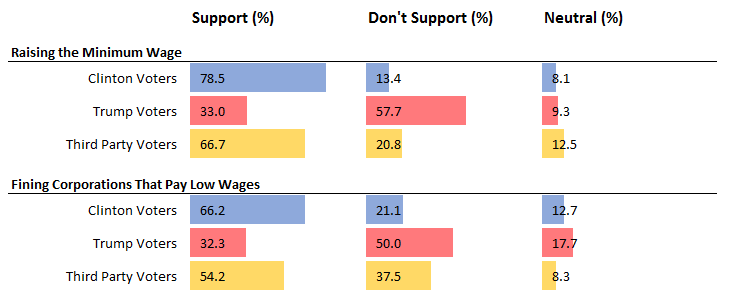
Raising the Minimum Wage – Voters on both sides of the minimum wage debate have strong feelings about the impact a raise would have. Among Clinton voters, it ranked first out of 11 of the policies tested as the one they thought would have the greatest positive impact. Contrarily, among Trump voters it ranked first as the policy they thought would have the greatest negative impact. Even Trump voters who were supportive of other progressive policies could be harshly critical of the minimum wage hike.
Samantha, 26, a white Trump voter from Gahanna, is in the teachers’ union at her school and said she supported people’s right to form a union. But she opposed raising the minimum wage to $15 an hour because she said it would “crazy inflate everything.”
Nevertheless, because so many Clinton voters support a minimum-wage hike — 78.5 percent — and because they believe it will have a greater positive impact than any other policy, it could be a potent mobilizer. It could prove especially effective at mobilizing the lower-income voters that Democrats have so much trouble turning out for midterm elections. The one potential problem is that in previous cycles, research has found that some low-income conservative voters will back a minimum wage increase and then pull the lever for Republican candidates. Still, our findings indicate that the minimum wage is a potentially powerful issue that deserves a closer look from progressives in 2018.
Fining Corporations That Pay Low Wages – Fifty percent of Trump swing voters opposed a proposal to fine corporations if their wages are so low that employees need public assistance. Although 66.2 percent of Clinton voters backed the policy, it was the lowest level of support they gave to any progressive policy. Even voters in households making less than $50,000 a year were lukewarm toward it, with just 66 percent of them backing the policy. Overall, just 53.2 percent of voters support the policy; and of all 11 policies we tested, it ranked 10th as the one voters thought would have the greatest positive impact. These numbers suggest this issue would be motivating for few voters.
4. Candidates’ paid media has not been getting through to voters, leaving them with little information, low opinion of elected officials
In Ohio’s 2016 race for the U.S. Senate, the two top candidates and their supporters spent an estimated $90 million, with a huge share going to TV ads and other paid media. And yet 53 percent of the swing voters we surveyed did not know or had no opinion of Sen. Rob Portman, one of the candidates in that race. During last year’s presidential race, Clinton’s campaign spent dramatically more money than Trump’s campaign on TV ads in Ohio and other battleground states. But it’s likely that many of those ads never penetrated the Fox News bubble that many Trump swing voters live in. And exit polls show that Ohio voters in 2016 reported receiving far less direct contact from campaigns at their doors than they had in 2012. Without that face-to-face contact, it becomes much more difficult, if not impossible, to counter the right-wing noise machine.
CHART 5. VOTERS’ SOURCE OF POLITICAL NEWS
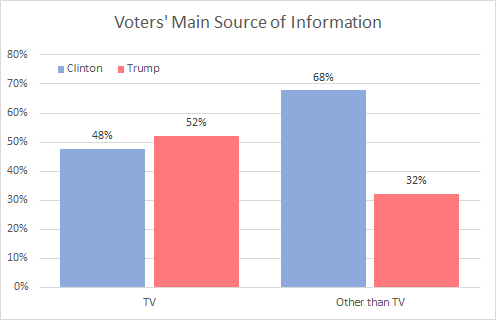
4.A. Voters See “All Politicians” as Responsible for Economy in Last 10 Years
Likely midterm voters tend to be better off financially than the average voter. And yet even among this cohort in Ohio, just 23.3 percent said they’ve experienced positive economic change in the last 10 years. A much larger share, 39.4 percent, said there has been no change in their economic fortunes over the last decade. It seems that many, if not most, Ohio voters feel like they’ve been treading water.
Susette, 33, a white Clinton voter from Hilliard, explained how she and her husband have struggled with student debt since getting out of college. “That’s the big lie that people tell you,” Susette said. “‘Go to college and when you graduate a job will be available that will pay it off.’”
Interestingly, Trump and Clinton voters reported similar economic experiences: 22.3 percent of Trump voters and 23.2 percent of Clinton voters said their economic fortunes had improved; and 39.4 percent of the former and 38 percent of the latter said there had been no change.
Who’s responsible for the economic problems of the last decade? Obama argued that he had to pull the economy out of the ditch that former President George W. Bush drove it into. Trump insists that he inherited “a mess” from Obama. But the swing voters of Ohio don’t make those distinctions. Both Clinton and Trump voters are more than twice as likely to blame “all politicians” for the state of the economy than any other group, including Republicans, Democrats or Wall Street. Thirty-seven percent of Trump voters and 34.1 percent of Clinton voters blame “all politicians” for the state of the economy. And those numbers rise even higher for third-party voters (43.5 percent) and people who didn’t cast a ballot in 2016 (61.5 percent).
A sense that “all politicians” have betrayed them may help explain why some Obama voters from 2008 and 2012 swung to “outsider” Trump, and why so many Democratic base voters didn’t turn out.
5. Many Trump Swing Voters Live in a Fox News Bubble, but Progressives Can Reach Them with Face-to-Face Conversations
Voters’ low information is combining with right-wing media narratives to cement a low opinion of all politicians. Voters repeatedly told our canvassers that they do not see elected officials dealing with issues important to them. The upshot is that voters blame elected officials for rigging the system more than they blame the corporate beneficiaries of rigged rules. If progressive candidates want to change that narrative in 2018, door-to-door contact and other direct outreach will be essential.
Fifty percent of the Trump voters we talked with in Ohio said they get their news from Fox or another TV outlet. By contrast, just 30 percent of Clinton voters rely on TV as their primary source of news. Because Trump swing voters often have such a narrow media diet, many of them are largely cut off from progressive ideas.
But our canvassers have learned that it’s possible to breach the Fox News bubble. More than a few Trump swing voters find progressive policies appealing if they actually hear them.
Elaine, 70, a white Trump voter from Grove City, said she watches Fox News “from in the morning till I go to bed.” Elaine is for Trumpcare, but when our canvasser told her about raising wages and other progressive policies, she was sympathetic because she sees her adult kids struggling with low pay and poor benefits.
Susie, 69, a white Trump voter from Circleville, said she watches Fox News because when she changes the channel she feels “like taking an antidepressant they’re so negative.” Though she’s a strong Trump supporter, she “likes the sound” of the policies to raise the minimum wage, improve retirement savings and establish paid leave.
There is reason to believe that many more Trump swing voters are persuadable — if they hear a progressive message from a trusted messenger at their door.
5.A. What Ohio Voters Are Looking for from Their Elected Officials
Every day, it seems, a new opinion poll is released showing that Americans’ trust in government and their elected officials has sunk to a new low. That ever-increasing skepticism is making it harder and harder to build a progressive politics. With this project, we wanted to explore ways to reverse that trend, so our canvassers asked voters a simple, open-ended question: How could an elected official show you they were on your side?
We got hundreds of responses from Ohio voters, but we feel they can be broken down into four basic recommendations:
Below is a small sample of the responses we received from Ohio voters, where they express those four ideas in their own words.
Harry, 53, a white Trump voter from Hilliard and federal law enforcement officer, said politicians need to be “visible and represent their constituents, not the interests who have their attention now … they need to be here with the people. It’s like an upper-management, out-of-touch problem.”
Willie, 51, an African-American Clinton voter from South Columbus, said, “These politicians need to know they don’t have a clue what you and I go through.” He was frustrated by the lack of school programs in his neighborhood and said, “The different areas of the city where people of color and poor people live don’t get the resources or attention the other parts of the city do.”
Kellen, 41, a white Clinton voter from Gahanna, said we need new politicians who don’t think about their “party” but focus on working together. “I am so sick of people saying ‘left’ or ‘right.’ Those aren’t useful or meaningful at all. We need people who disregard the labels, who care about their constituents and not the next election.”
Donna, 63, a white Clinton voter from Mansfield, said she’s concerned with the partisanship in D.C., but she feels that both Gov. Kasich and Sen. Brown break that mold. “I’m not a Republican, but I do like our governor; he’s for the people,” Donna said. “Sherrod Brown doesn’t deviate from helping the people [either]. He’s like a next-door neighbor, and not just because he grew up down the block.”
5.B. How Central Ohio Voters View Their U.S. Senators
We asked central Ohio voters whether they approve or disapprove of the job their U.S. senators are doing. Democratic Sen. Sherrod Brown had dramatically stronger approval than Republican Sen. Rob Portman overall, and the Democrat enjoyed stronger approval among Clinton voters than the Republican did among Trump voters. However, both senators were largely unknown to roughly half of the voters we talked with. Even voters with serious political concerns were often unfamiliar with them.
Tara, 28, a Clinton voter and teacher from Columbus, came to the door with a newborn. Tara said she’d like to stay at home to raise her child, but has to work because even as “a married, middle-class woman, my husband’s income isn’t enough to support us.” She backed most of the progressive policies we asked about and was an NPR listener, but knew very little about either senator.
Approval Ratings of Ohio’s U.S. Senators
Sherrod Brown Received Strong Approval Ratings from Clinton Voters: 56 percent of Clinton voters approved or strongly approved of the job Brown is doing; only 4 percent disapproved or strongly disapproved, and 40.1 percent didn’t know, were neutral or wanted to wait and see.
Brown Almost Broke Even with Trump Voters: 17.3 percent of Trump voters approved or strongly approved of the job Brown is doing, 20.4 percent disapproved or strongly disapproved and 62.3 percent didn’t know, were neutral or wanted to wait and see.
Portman Struggled with Trump Voters: 24.5 percent of Trump voters approved or strongly approved of the job Portman is doing, 19.4 percent disapproved or strongly disapproved and 56.1 percent didn’t know, were neutral or wanted to wait and see.
Portman Is Under Water with Clinton Voters: 10 percent of Clinton voters approved or strongly approved of the job Portman is doing, 39.3 percent disapproved or strongly disapproved and 50.7 percent didn’t know, were neutral or wanted to wait and see.
We also asked voters to share long-form thoughts about the senators. Here’s a sample of what they had to say:
Larry, 69, a Trump voter from Delaware, was all over the political map. He was for a $15 minimum wage, Trumpcare and unionization. When asked about Sherrod Brown, he said, “He’s a Democrat, right?” and gave two thumbs down. As for Portman, Larry wishes he was “more supportive of our president.”
William, 56, a Clinton voter from Grove City, works in the health care field and opposes Trumpcare. He’s disappointed that Portman “seems to not be able to make up his mind and do what is right for Ohio, let alone the U.S.A.” He says Sherrod Brown “fights against the banks and Wall Street … we are lucky to have him in the Senate.”
Cynthia, 66, a white Trump voter from Gahanna, said jobs and wages was her top issue and that she was against Trumpcare, despite casting her ballot for him in 2016. “Sherrod Brown works hard for his constituents,” Cynthia said. She called Portman “a career politician who only cares about who is paying him.”
APPENDEX 1. MIDTERM VOTER SUPPORT OF POLICIES BY 2016 CANDIDATE CHOICE
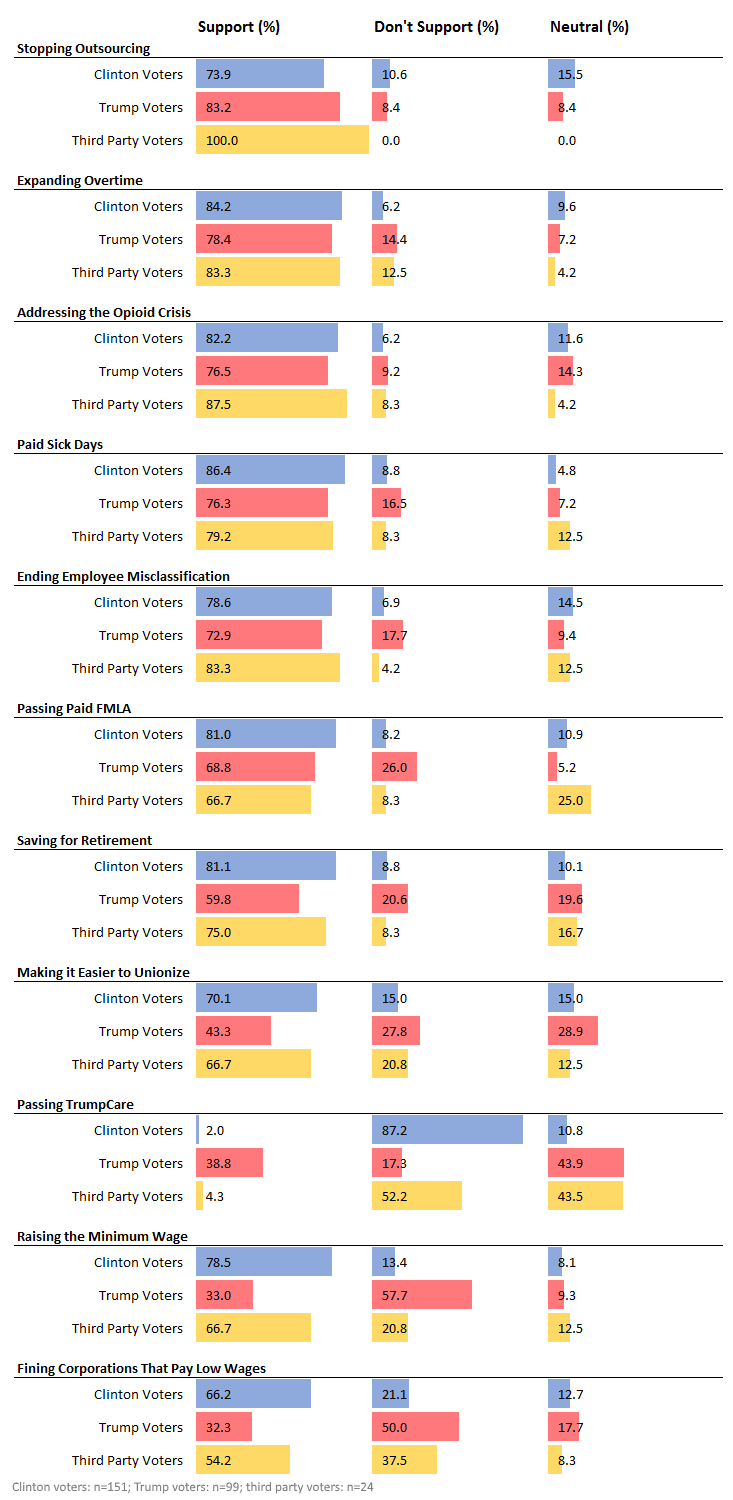
APPENDIX 2. WHICH POLICIES DO VOTERS SAY WOULD HAVE BIGGEST IMPACT ON THEM?
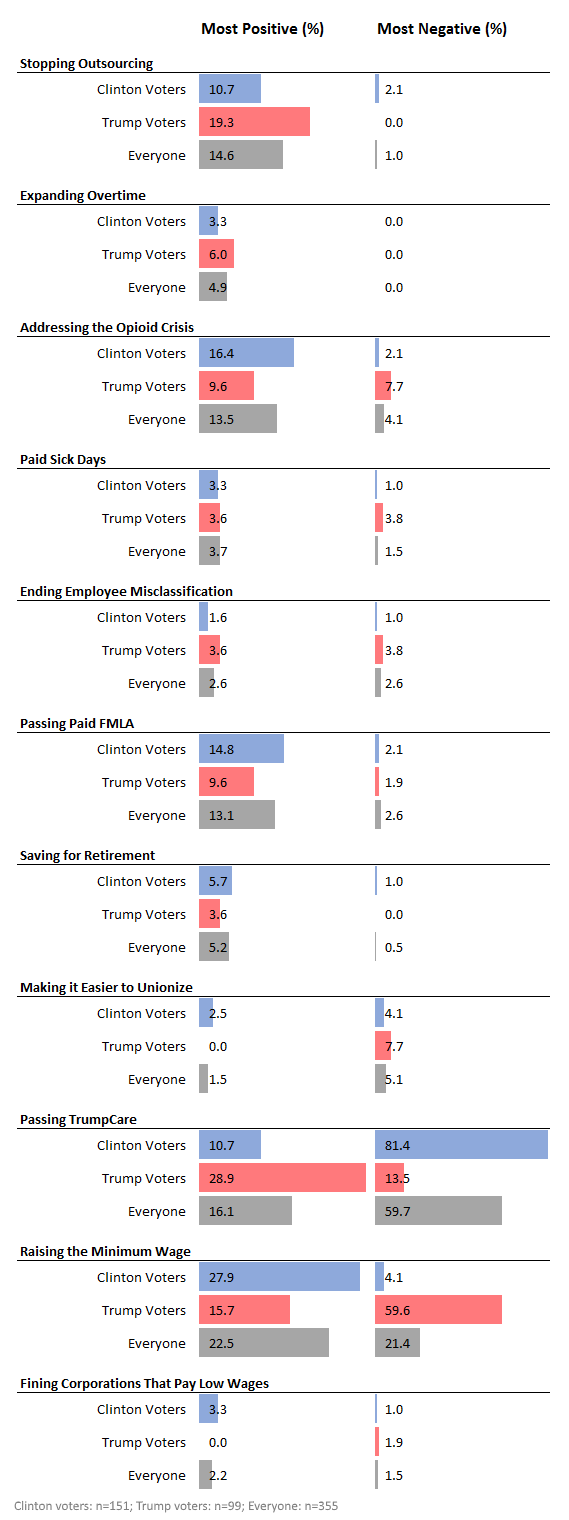
METHODOLOGY
Unlike traditional public opinion polling, which is based on a random sample of people
representative of a given population, we targeted likely swing voters in working-class and middle-class communities largely in central Ohio but also ranging as far north as Mansfield. We selected voters who cast a ballot in at least one non-presidential election since 2010, which suggests they’ll likely vote in 2018. These voters landed squarely in the middle of the partisan spectrum with an average Catalist Vote Choice partisanship score of 48.2 (on a scale of 0-100, 0 being most Republican and 100 being most Democrat). The estimated household income of voters averaged roughly $88,000 a year. Though we did not seek a representative sample of all voters, we did seek to interview voters who broadly reflect the demographic and political makeup of likely swing voters in the region.
From June 5 to June 16, we canvassed 355 registered voters. Their voting preferences in the 2016 election broke down as follows: 47.6 percent said they voted for Clinton; 31.2 percent said they voted for Trump; 7.6 percent said they voted for a third-party candidate; 8.8 percent didn’t share their presidential choice or didn’t talk to canvassers; and 4.7 percent said they did not vote. We believe this substantially undercounts the actual percentage of Trump voters we talked with. From looking at the voter file and historic records on candidate choice, we believe the bulk of voters who didn’t share their presidential choice were Trump voters. We believe the share of Trump voters was closer to 40 percent. This candidate preference is more in line with the communities we canvassed in central Ohio, which is a fairly Democratic part of the state. As far as a demographic breakdown, the canvassed populations skewed slightly female over male (51.55 percent to 48.55 percent). Ninety-eight percent of voters were white, 1 percent were African-American, none were Latinx, 0.3 percent were Asian and the ethnicity of 0.3 percent was unknown. The predominant age groups were people 30 to 49 (43.45 percent) and 50 to 69 (37.18 percent).
Canvassers sought to understand voters’ thoughts in three broad areas: what they think about a range of public policy options, what issues they consider most important and how they feel their families and communities are faring, and finally, what they feel about politicians in general and specifically about Ohio’s two U.S. senators. Individuals could choose not to answer a specific question, which resulted in somewhat different totals for each response.
We deployed canvass teams in the following seven Ohio cities and towns: Circleville, Columbus, Delaware, Gahanna, Grove City, Hilliard and Mansfield.
ABOUT US
Since 2003, Working America has mobilized working people who don’t have the benefit of a union at work to fight for good jobs and a fair economy. As the 3-million-member community affiliate of the AFL-CIO, we unite working people in urban and suburban communities around a shared economic agenda. www.workingamerica.org
We use cookies and other tracking technologies on our website. Examples of uses are to enable to improve your browsing experience on our website and show you content that is relevant to you.